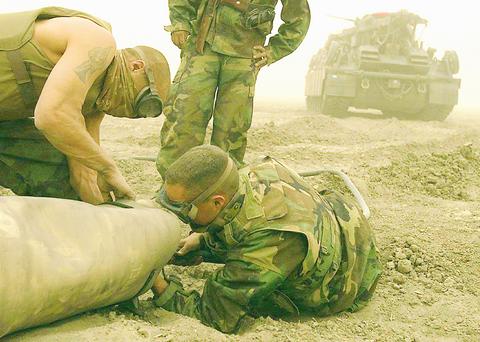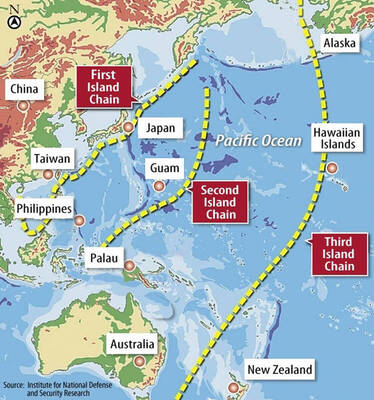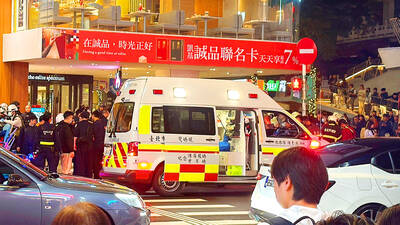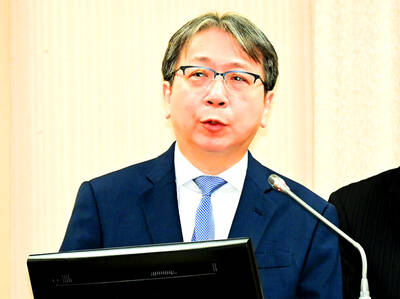While the front-line combat troops receive the lion's share of the coverage and credit in the war in Iraq, a critical and increasingly dangerous campaign to supply them is being waged behind the lines.
The ambush on Sunday of an Army maintenance company near Nasiriya illuminated the risks faced by the unglamorous but essential troops who carry food, fuel, water and ammunition to front-line troops.
The attack has raised questions about whether the force assembled to overthrow Saddam Hussein is not only large enough to accomplish its mission but also to protect its supply lines, which now run 482km north from Kuwait.

PHOTO: AP
Senior commanders in Washington and at Central Command here insist that the 300,000 troops in and around Iraq are adequate for both jobs. But they are now also shifting the focus of the ground campaign away from Baghdad and back to the south, with the goal of defeating the fedayeen and other Iraqi irregulars who threaten supply columns.
Even before this change in tactics, the threat of hit-and-run attacks on supply routes and the 18,927-liter tanker trucks moving fuel to combat formations had forced field commanders to divert some troops to protect those units ferrying war-fighting material to the front.
Commanders had already beefed up protection around the supply convoys, which can stretch for kilometers. The fuel tankers make especially inviting targets, so supply lines had been patrolled by attack helicopters and cargo vehicles accompanied by Bradley fighting vehicles.
Experts in military logistics agree that the rapid multi-pronged advance toward Baghdad and the guerrilla activity behind the lines pose significant risks to the supply lines and the soldiers who must keep them open.
"You have your lines of communication extended, in some cases for hundreds of miles, and that makes this problem very, very difficult to manage," said General John Coburn, the retired head of the Army Materiel Command. "It's exacerbated by the environment and my guess is you've got shortages of parts, people repairing equipment right on the battlefield and constantly being forced to adapt to the combat commander's maneuver plan."
In addition, Coburn said, leaders of logistical units must handle growing numbers of prisoners of war and provide food and other aid to Iraqi civilians.
"When you look at this task, you have to start with the lines of communication and ask how much force is being dissipated in protecting them and how much risk is being taken," said Major General William Nash, a retired officer who commanded a brigade of the 3rd Armored Division during the Gulf War.
"Some amount of potential combat power is being used to protect and secure those supply lines," Nash said.
It is difficult to conceive the volume of supplies required for a large combat force or the difficulty of delivering them where they are needed in a timely fashion.
Fuel is a critical concern. The tank battalions, helicopter squadrons, attack aircraft, Marine maneuver units and warships in the Iraqi theater consume almost 57 million liters of fuel a day, according to Major General Dennis Jackson, director of logistics and engineering at Central Command headquarters here at Camp As Sayliya, outside the Qatari capital of Doha.
He said in an interview on the eve of the war that it was possible that the fast-moving forces could outrun their supply lines, limiting the speed of advance. The sandstorms and high winds in Iraq on Tuesday limited combat operations, while providing some relief to beleaguered supply officers, giving them a chance to refuel vehicles and move food, water, ammunition and medical supplies up the line.
Current military doctrine calls for establishing relatively small battlefield depots or "supply nodes" near the front to quickly deliver critical supplies to front-line troops, rather than building large, semi-permanent warehouse complexes. Captured airfields are sometimes used for this purpose, allowing the use of C-17 transport planes and heavy-lift helicopters to bring in supplies rapidly.
"The issue," Jackson said, "is the last tactical mile."
The small depots are abandoned as troops move forward, or left with a small guard contingent to maintain them for the withdrawal of troops at the end of the conflict.
The Marines have established one such "forward arming and refueling point" not far from their forward lines. It provides fuel for the corps' helicopters and combat vehicles and replaces rockets and machine-gun ammunition consumed in the fighting.
Troops fighting in desert conditions also consume gigantic quantities of water, several quarts per day per soldier. For the most part, that is being hauled in on tractor-trailers, but logistics officers are also planning to deliver purification equipment so that local water can be used.
Coburn said that he believed that General Tommy Franks, the overall commander of the Iraq force, has enough troops to prosecute the war and protect his supply lines. He said that supply troops, mechanics and combat engineers are in many cases capable of defending themselves.
But there is a clear difference in the battlefield training of a combat soldier or pilot and that of a truck mechanic, even one in uniform carrying a rifle. As a result, commanders are moving to give the more vulnerable supply troops added protection.

The US government has signed defense cooperation agreements with Japan and the Philippines to boost the deterrence capabilities of countries in the first island chain, a report by the National Security Bureau (NSB) showed. The main countries on the first island chain include the two nations and Taiwan. The bureau is to present the report at a meeting of the legislature’s Foreign Affairs and National Defense Committee tomorrow. The US military has deployed Typhon missile systems to Japan’s Yamaguchi Prefecture and Zambales province in the Philippines during their joint military exercises. It has also installed NMESIS anti-ship systems in Japan’s Okinawa

TRAGEDY STRIKES TAIPEI: The suspect died after falling off a building after he threw smoke grenades into Taipei Main Station and went on a killing spree in Zhongshan A 27-year-old suspect allegedly threw smoke grenades in Taipei Main Station and then proceeded to Zhongshan MRT Station in a random killing spree that resulted in the death of the suspect and two other civilians, and seven injured, including one in critical condition, as of press time last night. The suspect, identified as a man surnamed Chang Wen (張文), allegedly began the attack at Taipei Main Station, the Taipei Fire Department said, adding that it received a report at 5:24pm that smoke grenades had been thrown in the station. One man in his 50s was rushed to hospital after a cardiac arrest

‘WIN-WIN’: The Philippines, and central and eastern European countries are important potential drone cooperation partners, Minister of Foreign Affairs Lin Chia-lung said Minister of Foreign Affairs Lin Chia-lung (林佳龍) in an interview published yesterday confirmed that there are joint ventures between Taiwan and Poland in the drone industry. Lin made the remark in an exclusive interview with the Chinese-language Liberty Times (the Taipei Times’ sister paper). The government-backed Taiwan Excellence Drone International Business Opportunities Alliance and the Polish Chamber of Unmanned Systems on Wednesday last week signed a memorandum of understanding in Poland to develop a “non-China” supply chain for drones and work together on key technologies. Asked if Taiwan prioritized Poland among central and eastern European countries in drone collaboration, Lin

ON ALERT: Taiwan’s partners would issue warnings if China attempted to use Interpol to target Taiwanese, and the global body has mechanisms to prevent it, an official said China has stationed two to four people specializing in Taiwan affairs at its embassies in several democratic countries to monitor and harass Taiwanese, actions that the host nations would not tolerate, National Security Bureau (NSB) Director-General Tsai Ming-yen (蔡明彥) said yesterday. Tsai made the comments at a meeting of the legislature’s Foreign Affairs and National Defense Committee, which asked him and Minister of National Defense Wellington Koo (顧立雄) to report on potential conflicts in the Taiwan Strait and military preparedness. Democratic Progressive Party (DPP) Legislator Michelle Lin (林楚茵) expressed concern that Beijing has posted personnel from China’s Taiwan Affairs Office to its